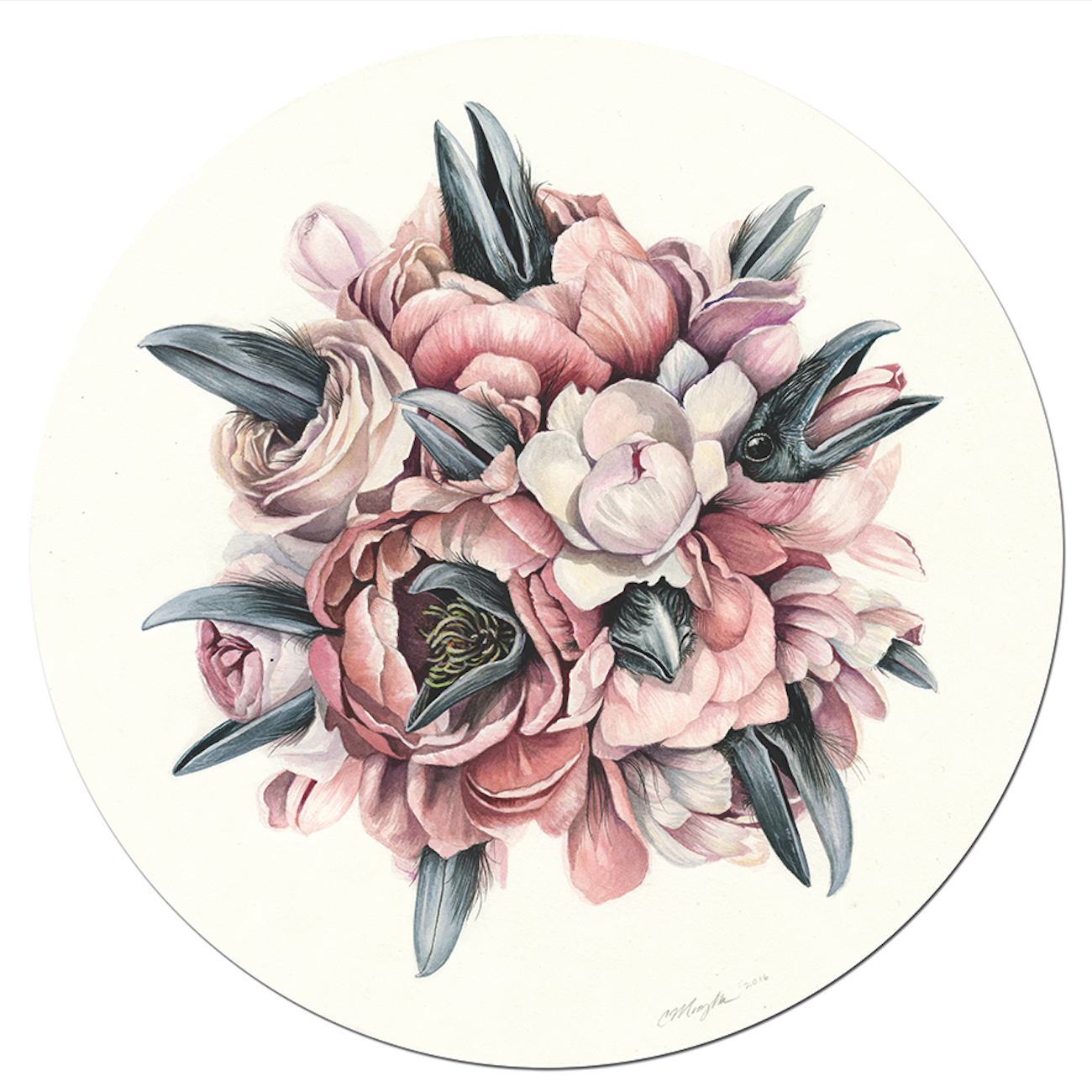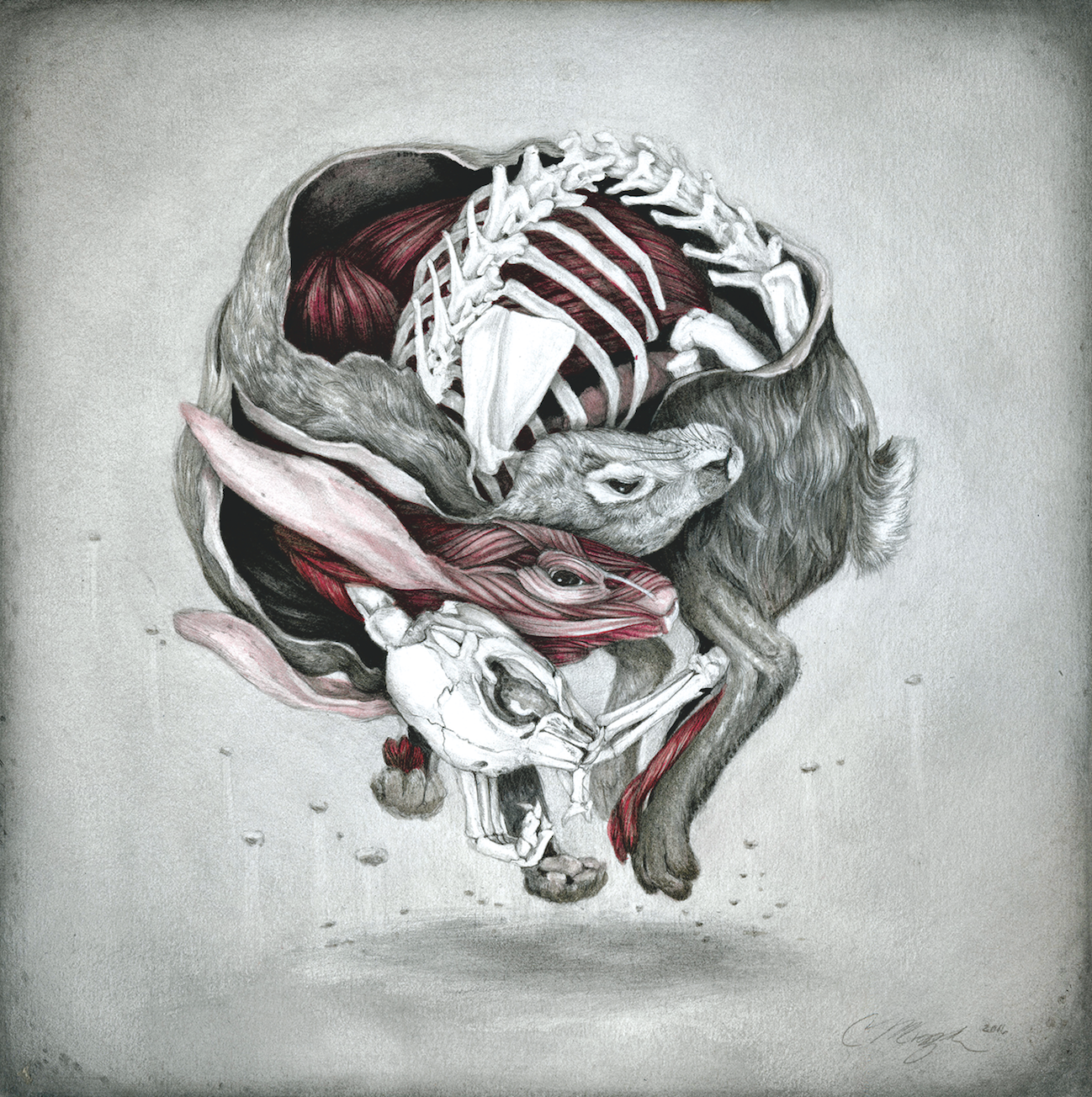Portland artist Christina Mrozik


The characters in Christina Mrozik’s work seem to transcend time and space. They create their own fantastical universe where life and death can coexist within just one frame. In each piece, the splendor of creation and color dance an elegant waltz alongside their partners — darkness and decomposing death. As the viewer takes in this metaphorical dance, the significance of balance and contrast begins to be understood through the artist’s perspective. An artist whose work expresses both a deep sense of introspection and social examination, Mrozik has contributed her art and expertise in the nonprofit realm and can be seen at the Antler Gallery in her upcoming showing in May.
Eleven: I saw that you are from the Midwest — Michigan — and you said you always bring that aspect of yourself into your art. How would you say you do that?
Christina Mrozik: We are all creatures of where we were raised. What I love most about the Midwest is the warmth of the people and the hard-working, open spirit that comes from growing up in the wide open fields of farm country. I’m shaped by people who have strong seasons to their lives, and I notice a similar trend in my art-making. I’m always continuing to practice while moving through times of both harvest and hibernation.
11: Why did you choose to come to Portland?
CM: I first came to Portland a couple years ago while on an artist residency in eastern Oregon. I was looking to try something new and it felt like a good fit. I love to explore, but had been feeling a bit restless and in need of a roost. After meeting the owners of Antler Gallery, where I often show, I thought I could be part of the art community here. I went home, packed everything I owned into my car, and headed west.
11: On your website you discuss how much you enjoy traveling and exploring new places as inspirations for some of your work. What’s been an exciting new discovery you have made lately?
CM: In October, my sweetie and I traveled to Ireland for the first time. When I travel somewhere new, I find the landscape, people, and flora/fauna don’t necessarily directly translate and appear in my work; rather, the mood of a place starts to take hold. Ireland was full of green openness: a vast and somber place of song. When I feel that kind of spirit, it becomes a part of me and moves with me and out of me in a more subtle and natural kind of way. The discoveries are inward and I realize a piece of myself I didn’t know before.

11: What is the significance of nature in your work?
CM: This, to me, feels like asking what the significance of air is. An Irish poet I love, John O’Donohue, talks extensively of the effect of landscape on the human soul. He says that one’s outward experience with beauty directly and profoundly affects [one’s] own inner landscape. It’s something that almost vanishes when I try to put words to it, but it is a feeling we all know when we stand beneath a Redwood tree. If one could learn to carry that profoundness of the world [everywhere], I believe it would open the heart to empathy and the lesson that each human is also an endless landscape that can be walked.
11: You have said, “Humility makes great work,” as well as knowing yourself. What do your pieces say about who you are?
CM: Humility is often misconceived as not taking credit for something in order to be perceived as humble. What I think it actually is, is the powerful act to say, “I’m here. I have these abilities. How can I use them to serve my community?”
If someone is brilliant at something but uses it only to serve oneself, they are drowned by ego and thus ineffective. If someone is brilliant but they downplay that ability to be perceived as humble, they help no one and are doubly under the influence of ego, as they are so worried about how they’re perceived that they don’t contribute.
Humility is that sweet spot of working hard to master something and then offering it back to your community with open hands, asking, “how can I help?” Just as powerful, humility is saying, “This is not the thing I’m brilliant at; where can I get help? Who should be leading this and how can I support them?” That is the power of humility, understanding that it is not only about you, but you play a vital role in a larger something.
Knowing yourself and what you are both great at and not-so-great at allows you to understand where and when to step up or to let go of the reigns and get help. I try and use my art to tell these kinds of stories and use my own experience to be vulnerable about what I’ve learned and where I’ve failed. It’s a walk of honesty, sharing a piece of my diary through metaphor. I’m good at existing in the cracks that lack clarity and definition, so I try and bring more emphasis to the importance of the intangible.
11: You are an artist of several different mediums. Is there a type of visual artist that you would consider yourself to be? What is the name of the style of art that you make?
CM: Naming styles has always been tricky for me because — I’ll say it — I don’t know my history well enough. I draw from the naturalists and add surrealist elements, but I work in paint and graphite and clay. As my pieces are paired with prose, they could be classified as illustration, so maybe I’m a poet-naturalist making surrealist illustrations and sculpture. Or something like that.
11: You have touched on the personal significance of coming to terms with death and disease and how the duality of life and death interplay in your work. Why do you think it is significant to come to terms with death?
CM: I’m not sure if one can really come to terms with life if they haven’t come to terms with death. There is so much cultural fear surrounding the end that it shrouds the present. There is an awakening that happens when someone kisses death, as if all color is realigned, a shift in both focus and priority. For myself, I feel like it allows me to better sit with someone in their dark, being a listener rather than a fixer. It helps me think about longevity and what will be left behind for future generations, because the world doesn’t end when I do. It also, strangely, makes me more comfortable with silence, because I’m OK with bringing the harder things into focus rather than drowning them out with noise.

11: One quote I really loved by you is “art fills the void that language can’t.” Do you think you can expand on that concept? Give an example where you felt like art has done this for you.
CM: It’s a little funny to try and use words to explain but I’ll try. Language in a day-to-day sense is typically used to convey specific understanding and communicate clarity. Art tends to remove that clarity and create a visual representation of the imagined or perceived. It exists primarily in the world of metaphor, feeling, color and light; it affects the senses differently.
I love the famous painting “Christina’s World” by Andrew Wyeth. When I look upon it, I could write paragraphs expressing the feeling of the piece: the woman’s longing, the secret desire, the desolation and solitude. I could give the history of her disability and explain her situation and the memories of that barn she’s leaning toward. Instead, when I gaze upon the painting there’s a feeling, a kind of immediate knowledge about her, a common ground of the human heart in which I empathize with her hunger. Thus, through this process, this woman’s character becomes an icon of everyone’s hunger. It gives me a sensation with an immediacy and depth that is different from an article, novel or poem. It interacts with time differently.
11: You have also mentioned being part of nonprofit organizations and getting involved. Can you tell us about the type of work you have done there? Why do you like to be involved?
CM: I’ve worked with a few different organizations over the years. Five years ago in Maine I was an illustrator for the Beehive Design Collective, an all-volunteer, activist arts collective dedicated to “cross-pollinating the grassroots” by creating collaborative, anti-copyright images for use as educational and organizing tools. In Michigan, I worked at a youth nonprofit arts center, CultureWorks, teaching kids comic-making and the importance of creative problem solving. Every year I go to Rabbit Island in Lake Superior with a group of incredible high schoolers, and we talk philosophy, discuss our imprint on the planet and submerge ourselves in beauty (they teach me how to laugh and fall in love over and over). I also donate art through Antler Gallery’s yearly “Brink” show to support our local Portland Audubon Society.
It’s not simply a responsibility to participate — it’s a joy. It teaches me how to connect with my community. It sheds light on both problems that need fixing and movements focused on fixing them. It creates a space for shared experience, laughter and hope. Working with nonprofits helps me be a more collaborative human.
11: Tell us about your newest work and projects and what you have coming up.
CM: I have a new solo coming up at Antler PDX in May. I’m still working through what that will look like, but there will be grass bodies, collaborative pieces, prose and magic.
11: Is there anything you would like to add?
CM: Always remember to be so kind to yourself. Practice often. Learn what voice is yours and speak it. Take your time. Be good to your body. Ask questions. Listen well. Enjoy the mystery.»
-Lucia Ondruskova



